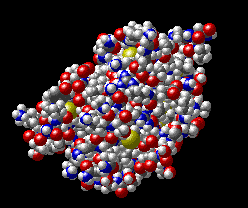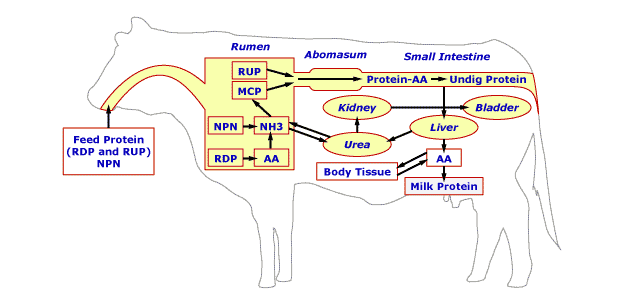Previous Page | Right click this page to print.
Proteins
The third of the six nutrients is protein. Chemically, proteins are extensive chains of amino acids. Amino acids are often abbreviated AA. Figure 2.6 illustrates the basic chemical structure of an amino acid. All amino acids contain four basic components linked to a carbon skeleton. The four basic components are a hydrogen, an amine, a carboxyl, and a side chain, commonly referred to as the R group. The specific R group determines the specific amino acid. All amino acids contain an amine, therefore all proteins contain nitrogen.

Individual amino acids are linked via a peptide bond. The specific amino acid sequence and subsequent linkages between components of the amino acids, determine the chemical and physical properties of the protein. Figure 2.7 illustrates the complex structure of a protein. In Figure 2.7, each color represents a specific atom such as nitrogen, carbon, hydrogen, an oxygen, etc.

In the body, protein is the nutrient present in the second greatest concentration. The primary functions of proteins are to aid in structure, movement, digestion, metabolism, growth, and defense.
At the cell level, protein synthesis is regulated by deoxyribonucleic acid or DNA. DNA is found within the cell nucleus of each cell. Specifically, DNA determines the sequence of amino acids and therefore the protein and its associated characteristics. As protein synthesis requires specific amino acids in precise sequences, deficiencies of specific amino acids limit synthesis of proteins requiring those amino acids. The deficient amino acid, limiting protein synthesis, is referred to as the limiting amino acid. The limiting amino acids of concern for monogastrics such as poultry and swine are lysine, methionine, and tryptophan. As will be discussed later, protein nutrition for ruminants is different than protein nutrition for monogastrics. In general, limiting amino acids are not a concern in ruminant rations. However, limiting amino acids are of concern for high producing animals such as lactating or rapidly growing ruminants. Limiting amino acids of concern for high producing lactating dairy cows are lysine and methionine. The proteins in an animalís body are composed of 20 amino acids. Table 2.1 lists the amino acids.
| Essential AA | Nonessential AA |
|---|---|
| Arginine | Alanine |
| Histidine | Aspartic acid |
| Isoleucine | Citrulline |
| Leucine | Cystine |
| Lysine | Glutamic acid* |
| Methionine | Glycine* |
| Phenylalanine | Hydroxyproline |
| Threonine | Proline* |
| Tryptophan | Serine |
| Valine | Tyrosine |
| Taurine | *Additional amino acids required by chicks |
There are two sources of amino acids. One source is the animal. Within the animalís body, animals are able to synthesize amino acids. The second source is the diet. In Table 2.1, the amino acids are listed as either dietary essential or nonessential. The dietary essential amino acids are the amino acids that must be provided in the diet as the animals are not able to synthesize adequate amounts of the amino acid to fulfill their requirement. In contrast, nonessential amino acids are the amino acids not required in the diet as the animals are able to synthesize adequate amounts of the amino acid to fulfill their requirement. In Table 2.1, the nonessential amino acids with the superscript ď*Ē are additional dietary essential amino acids for chicks.
Dietary proteins provide the amino acids required for protein synthesis. However, the processes from consumption of dietary proteins to metabolism to tissue proteins differ between monogastrics and ruminants.
In monogastrics, dietary protein is digested in the stomach and the small intestine. Mammalian enzymes and other compounds degrade extensive proteins to their specific amino acids. Then, the amino acids are absorbed through the small intestine and enter the circulatory system. In monogastrics, the amino acid profile consumed is similar to the amino acid profile absorbed and subsequently used for protein synthesis in the animal.
For ruminants, protein nutrition is more complex. Figure 2.8 illustrates protein nutrition in a ruminant.

As illustrated, dietary or feed proteins are divided into three categories.
The first category is rumen inert protein. Rumen inert protein is also
known as rumen undegradable protein (RUP) or undegradable intake protein
(UIP). Rumen inert protein passes through the rumen unchanged. As the
protein continues to flow through the GI tract, it is exposed to mammalian
secretions and enzymes in the abomasum and small intestine. The portion
of the protein digested to amino acids will be absorbed in the small intestine.
The undigested portion will pass through the remainder of the GI tract
and be excreted in the feces. The second category is the rumen degradable
protein (RDP) or degradable intake protein (DIP). Rumen degradable protein
is digested in the rumen. Rumen microorganisms metabolize the protein
to ammonia (NH3). The rumen microbes use the ammonia to synthesize microbial
proteins. As rumen fluid and materials, including the rumen microbes,
flow out of the rumen and continue through the GI tract, the microbial
proteins will be available to the animal. Microbial proteins will be digested
in the abomasum and small intestine and the amino acids will be absorbed
in the small intestine. The undigested portion of the microbial proteins
is excreted in the feces. The third category is nonprotein nitrogen compounds,
often abbreviated NPN compounds. Similar to rumen degradable protein,
microbes are able to metabolize NPN compounds to produce ammonia and use
the ammonia for microbial protein synthesis. From there, the digestion
of microbial protein is as stated above for RDP. Microbial protein synthesis
is dependent upon substrate availability. The two most important substrates
are nitrogen and energy. If the availability of nitrogen as ammonia exceeds
the synthesis of microbial proteins, as illustrated in Figure 2.8, the
ruminant will absorb the ammonia and recycle the nitrogen in the body.
If the excess exceeds the ruminantís ability to recycle, the excess nitrogen
will be excreted in the urine.
As a result of the differential protein nutrition, there are differences in the protein requirements of monogastrics and ruminants. For monogastrics, the protein requirement is stated in terms of total protein. However, the total protein only includes true protein or protein composed of amino acids. In addition, the protein requirements for monogastrics include information on limiting amino acids. For ruminants, the protein requirement is stated in terms of total protein and includes both true protein and NPN compounds. The requirements are stated in terms of the total amounts and relative amounts for the three categories (i.e. RUP, RDP, and NPN compounds). And finally, for high producing ruminants requirements provide information regarding limiting amino acids.
Feed proteins provide a direct or an indirect source of amino acids to be used for mammalian protein synthesis. However, not all feed proteins yield the same total of each of the amino acids or same relative proportions of the amino acids. Therefore, there are a number of measures to describe the nutritive value of the protein source. As some of the measures are also used for other nutrients, Module III will discuss the measures. The measures to be discussed are digestibility, solubility, amino acid composition, biological value, and protein efficiency ratio.
Previous Page | Right click this page to print.